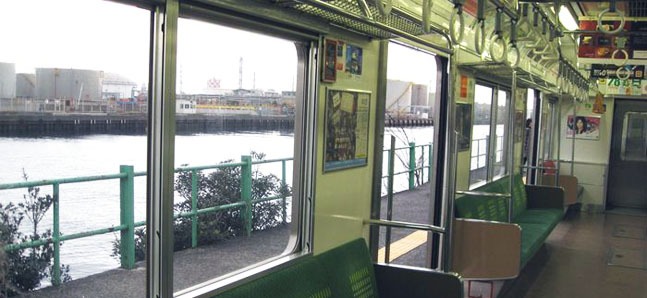
Posted: Thu Apr 15 2010
With Tokyo’s dense network of trains, it’s possible to go practically anywhere on the rails. Taking advantage of the unique train journeys that exist can turn the city in a completely new place. We’ve already gotten away on some of the trains less travelled (Escape from the branch lines); now we’ll travel a little further along the steel by transferring to a line that will warp you through scenery from the past, the present and the future.
The Tsurumi Line, which begins at Tsurumi Station on the Keihin Tohoku Line and runs along the coast between the eastern edge of Yokohama and Kawasaki, is made up of three sections: its main segment, which runs between Tsurumi and Ogimachi; its Okawa-shisen branch line; and its Umi-Shibaura-shisen branch line. Viewed on a route map, the Tsurumi Line takes on the shape of a letter ‘F’ that has fallen over to the right with one extra short line jutting out perpendicular to its normally upright section.
Although short in length, this remarkable line – with its two branch lines, three-carriage trains and elevated platform that, at Tsurumi Station terminal grandly sits one step higher than that of the Keihin Tohoku Line – exhibits some outstanding railway craftsmanship.
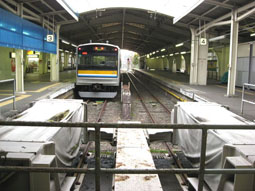
The land through which the Tsurumi Line runs was reclaimed during the closing years of the Taisho Period, for use by major domestic manufacturers in industries such as iron, steel, machinery and food –who built their factories here one after another. Originally built as a private railway, the line was then owned by Tsurumi Rinko Railway, who chose to build a dedicated platform at Tsurumi Station because of the line’s primary use for transporting people and materials to the area’s factories. The Japanese government bought the line during World War II, making it public as part of Japan National Railways, and although the line is now part of the Japan Railways Group (JR), its original role of transporting people and materials to the factories is largely unchanged.
After departing Tsurumi, the line crosses more than ten different lines, including the Keihin Tohoku Line, the Yokosuka Line, the Tokaido Main Line and the Keihin Electric Express Railway Line, via an overhead bridge, before making its first stop, at Kokudo Station. The station’s drab name (which means ‘national highway’) refers to the fact that the station sits directly next to the national highway that runs between Tokyo and Osaka (National Route 1). More interesting than the name of the station, is the area underneath it.

Underneath the early Showa era concrete archways that support Kokudo Station is a shopping street. Now a shabby old street that’s home to only a few small shops and yakitori-ten (grilled skewer shops) there isn’t really much ‘shopping’ to be done here anymore; however, with its pre-war concrete arches the street harbours its own unique atmosphere, and the street occasionally still features in various photo and film productions.
After curving through Kokudo Station, the Tsurumi Line continues above ground to arrive at Tsurumi-Ono Station. Located in an old residential area not far from a university, this small station comes alive with morning and evening commuters. Upon departing Tsurumi-Ono Station, however, the scenery changes from residential to industrial.
Curving to the left, the line passes the Tsurumi line train depot and arrives at Bentembashi Station, which was built on an unusually large scale to accommodate freight trains. From here, the line delves deeper into the industrial area for which it was originally built to serve.
Two minutes after leaving Bentembashi Station, the line reaches Asano Station, named after the family responsible for building the Tsurumi Rinko Railway. This naming practice wasn’t unusual, since the Tsurumi line is built on reclaimed land that obviously had no history of its own, leaving many of its stations to be named after people affiliated with Tsurumi Rinko Railway. From Asano Station, the first of the Tsurumi line’s branch lines – Umi-Shibaura-shisen branch line – begins.
After crossing over a short waterway, the line reaches Anzen Station – a station named after Zenjiro Yasuda (the station takes ‘zen’ from the first kanji in ‘Zenjiro’ and ‘an’ from an alternate reading of the kanji for ‘yasu’). Yasuda was an entrepreneur who supported the Tsurumi Rinko Railway and founded the financial conglomerate, Yasuda Zaibatsu. Between Anzen Station and the next stop, Musashi-Shiraishi Station, the line crosses from Tsurumi ward, in Yokohama, to Kawasaki ward, in Kawasaki; the scenery, however, remains the same.
At Musashi-Shiraishi the line diverges into its second branch line, the Okawa-shisen. As the rails of the Okawa-shisen break away from the main Tsurumi line, the curve was originally so sharp that modern day trains weren’t able to run on them; consequently, the Okawa-shisen branch line used pre-war trains that ran between Musashi-Shiraishi Station and Okawa Station – a point of nostalgia which has made this particular section of track famous amongst its fans. The curve was eventually renovated, allowing modern trains to run directly from Tsurumi Station.
Returning to the Tsurumi line’s main section, from Musashi-Shiraishi, the line curves to the left before arriving at Hama-Kawasaki Station, which is banked on its right by various large factories owned by the JFE Steel Corporation. After departing from Hama-Kawasaki Station, the line curves round to the right – towards the sea – before calling at Showa Station and then on to its last stop: Ogimachi Station.
At Ogimachi Station the Tsurumi Line, which runs through one of Japan’s greatest industrial regions – the Keihin Industrial Zone – comes to an abrupt end just 7km after departing Tsurumi Station. Despite this, as any fan of this unique line will tell you, it's a fifteen-minute train ride through Japan’s industrial past that shouldn't be missed.
The Umi-Shibaura-shisen branch line
The Tsurumi Line’s main section hasn’t changed all that much, however, in order to continue to service the industrial area, it has had to make some changes to keep up with the times. To get the full experience that the Tsurumi line has to offer, you’ll also need to experience one of its branch lines – with the Umi-Shibaura-shisen branch line being the more interesting choice.
At Asano Station, trains on the Umi-Shibaura-shisen branch leave the Tsurumi Line’s main section and fork sharply to the right. Immediately after completing the curve, with train wheels screeching on the rails as they turn, the line draws parallel to a waterway. Along the waterway, you’ll see small boats used for carrying freight, moored fishing boats and a sign that reads ‘kamome ni chui’, alerting people to the seagulls.
A little further along and the line reaches Shin-Shibaura Station, which serves the huge Toshiba factory that can be found just behind it, to the right. After departing Shin-Shibaura the scenery remains unchanged – the waterway to the left and the Toshiba factory to the right – until the line reaches its terminal station, Umi-Shibaura Station. Just like the station’s name (umi meaning sea) says, the platform at Umi-Shibaura Station is nested directly up to the sea. The platform here is, in fact, closer to the sea than any other platform in Japan and as such, railways buffs from all over Japan come to photograph it.
Originally, the station connected directly to Toshiba’s factory grounds, allowing only Toshiba’s personnel to exit the station; however, the station became so popular with visiting railway fans that Toshiba set up a small public park adjacent to the station. Looking out towards the sea, the scenery includes a view of both Tsurumi Tsubasa Bridge (part of the Shuto Expressway Bayshore Route) and Yokohama Bay Bridge.
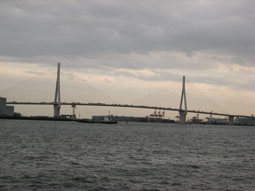
The factories that make up the Keihin Industrial Zone, through which the Tsurumi Line runs, are so densely packed together that, in places, their presence can be overwhelming. At night, when the factory lights come on, the atmosphere becomes so futuristic that if Ridley Scott had known about it when he made ‘Blade Runner’, he might well have used it in the film.
A 15 minute train ride that begins in an old shitamachi residential district and runs through an area full of industries pertaining to the past the present and the future, before finally reaching the ocean, the Tsurumi Line/Umi-Shibaura-shisen branch line combination has it all. However, a word of caution, because the line is mainly for factory workers and business personnel, the trains don't run terribly often outside of rush hours (with waiting times during normal daytime hours sometimes reaching up to two hours), so remember to check the train times before heading out. If you plan your trip well, you can head out from Tokyo, experience the Tsurumi Line time warp, and be back in the city within two hours.
Tweets
- About Us |
- Work for Time Out |
- Send us info |
- Advertising |
- Mobile edition |
- Terms & Conditions |
- Privacy policy |
- Contact Us
Copyright © 2014 Time Out Tokyo










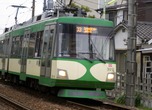
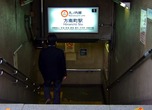
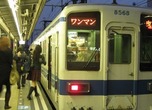

Add your comment